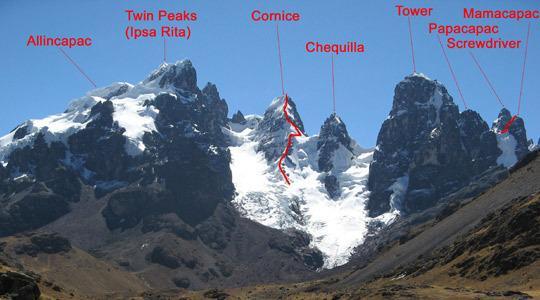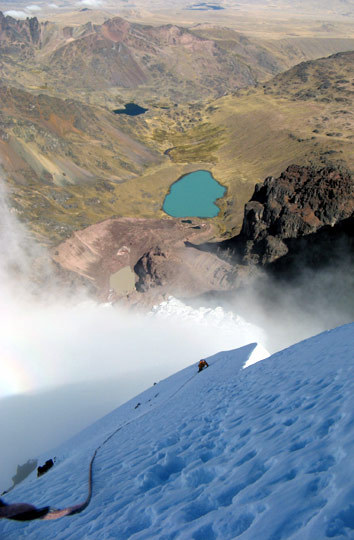
There is some confusion over the naming of peaks in the Cordillera Carabaya of southern Peru, with at least one expedition map being wrong. The 2007 British team believe the peak names marked on the photo are correct. They made the first ascent of the south ridge of Cornice (5710m) via the route marked, and the first absolute ascent of Mamacapac via the west ridge as marked. [Photo] Stephen Reid
British climbers Mike Cocker, Jonathan Preston and Stephen Reid made a rare visit to the Cordillera Carabaya, a compact massif that forms an arc east of the town of Macusani (4300m) in southern Peru. Although highly unfrequented by climbers, this area is exceptionally scenic and still holds potential. The main exploration took place during the late 1950s and 1960s, and until Scotland’s John Biggar and the guide Pere Vilarasau took a commercially organized expedition there in 2005, the last recorded new route occurred as long ago as 1981. This date was rather confirmed in the first valley visited by the 2005 party by a farmer who remarked that no other climbers had been into the range for more than twenty years.
The main objective for the 2007 expedition was the unclimbed south face of Chichicapac (5614m), the second highest mountain in the range and first climbed in 1959 by the legendary Italian explorer, Piero Ghiglione, and Forrunaro Mautino. Although there was a good Scottish-type gully splitting the face, it was threatened by huge cornices and thought too risky to attempt. Instead, on June 29, the three made the first ascent of the north ridge. From a col at a little over 5100 meters, five pitches of rather friable granite up to 5.7 led to easier snow climbing. The route was graded D, and the three descended the west ridge, thus making the first traverse of the mountain. Several minor tops on the north ridge had been climbed back in 1967 by Roger Whewell and party.
On July 3, the British team made the probable first ascent of Mamacapac (5525m), a spectacular rock spire that they ascended by a straightforward snow slope to a high col, followed by three pitches of easy-angled but horrendously loose rock to the top. Despite the poor quality route, which they graded PD, the climbers bagged what appears to be an unclimbed summit–something of rarity in Peru these days. Returning to the UK in 2005, Biggar had claimed the rock in this area to be akin to his local (and very high quality) granite in southern Scotland. However, this summer’s team felt that a qualification was needed; it was like southern Scottish granite–but put through a mincer and scattered liberally over the mountains.

Jonathan Preston on the final section of the south ridge of Cornice (5710m), Cordillera Carabaya, during the first ascent. This was the first time this peak had been climbed in forty years. [Photo] Stephen Reid
With Cocker out of action having sprained a wrist, Preston and Reid made the first ascent of the spectacular south ridge of Cornice (5710m). After an initial straightforward 250 meters, the ridge gave thirteen excellent pitches of continually interesting and exposed snow, ice and mixed climbing, finishing at the marginally higher end of a severely corniced ridge. The climb was done in one push from a bivouac on the moraine below the glacier, with descent by down climbing and rappelling the route (largely in the dark). The grade was D. The only known previous ascent of the mountain took place in 1967 when David Cooper’s New Zealand team climbed the east face to gain the south ridge at a point 60m below the summit.
After perfect weather the three left base camp in a blizzard and then spent several days trying to evade political unrest on their way back to Lima. All major roads were blocked with boulders, and the airport at Juliaca was overrun by demonstrators who had smashed the landing lights, and the team holed up in a hotel while police fired tear gas into slingshot-wielding mobs. In the end they were forced to run the gauntlet of stone-throwing hooligans in Arequipa, from where they managed to get transport to the capital and left Peru three days later than scheduled.